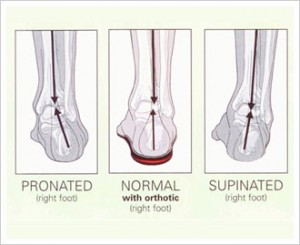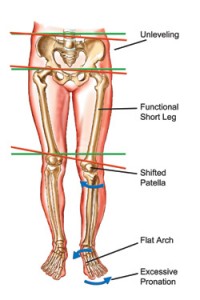What is Over Pronation?
 Over pronation is one of the most common foot functional disorders. It occurs when there is a mechanical imbalance that causes the foot to collapse inward when walking or standing, giving rise to the appearance of a low arch.
Over pronation is one of the most common foot functional disorders. It occurs when there is a mechanical imbalance that causes the foot to collapse inward when walking or standing, giving rise to the appearance of a low arch.
Appropriate mechanics and alignment at the feet is very important because the feet serve as one’s base of support. A functional problem at the base of support can translate up the lower extremity kinetic chain affecting mechanics and alignment at related joints. Over time, this pattern of suboptimal loading of joints in the lower extremity can lead to irritation and pain in the muscles, joints or ligaments at the feet, knees, hips and even low back.
Over pronation can cause or contribute to the following:
-
plantar fasciitis and heel spur formation
-
callusing of the big toe
-
bunion formation (or outward deviation of the big toe)
-
shin splints
-
knee pain (commonly irritation to the medial collateral ligament)
-
IT band syndrome
-
arthritis
How To Correct Over Pronation:
The best ways to correct over pronation are custom orthotics prescription and rehabilitation of the lower extremity. Custom orthotics provide passive support to the arch whereas rehab helps to strengthen muscles that support the arch and improve balance and posture. Best results are achieved by combining both. If in addition to over pronation there is pain, manual therapies such as chiropractic care can help the problem heal faster and more completely.
Rehab for Over Pronation:
1) Short Foot Posture
Please enjoy the short video demonstration of the short foot posture exercise. This exercise helps to raise and strengthen the arch as well as correct the position of the ankle and knee. You need to master this exercise in order to proceed through exercises 2-5.
2) Short Foot Heel Rise
To further challenge and strengthen the arch, perform the short foot exercise, then raise the heels. The heels should be pointing slightly more towards the mid-line than a straight heel rise. Start with 10 reps performing the exercise in slow, controlled movement. This exercise targets the tibialis posterior muscle which supports the arch.
3) Short Foot Squat
While maintaining the short foot, perform a squat. A squat is done correctly when a neutral spine is maintained and the knees don’t travel past the toes. This exercise is designed to groove appropriate motor patterns. Start with 10 reps.
4) Short Foot One Leg Stance
While maintaining a short foot, try to balance on one foot with the knee slightly bent on the standing leg. Try to hold this position for at least a minute. Repeat for the other side. This is an excellent proprioceptive exercise.
5) Short Foot One Leg Star Excursion
Only perform this exercise if you have mastered the previous 4. This one is very challenging. While maintaining a short foot, stand on one leg with the knee slightly bent (as above). Imagine you are standing in the middle of a clock. Slowly point the toe of the non-standing leg from centre to a point on the clock and back to centre and to the next point and so on (as if you are tracing the outline of a star with many points). Focus your attention on keeping the standing leg strong and solid, only moving your non-standing leg. Repeat this pattern 3 times, then repeat on the other leg. This exercise is another excellent proprioceptive exercise which trains appropriate co-contraction of lower extremity muscles to maintain balance.
6) Bridge Exercise
Bridge exercises are great for strengthening the gluteal muscles. Gluteal muscle weakness often contributes to the over-pronated foot position.
Dr. Elisabeth Miron
Are you looking for custom orthotics in Aurora? Visit Dr. Miron’s website!